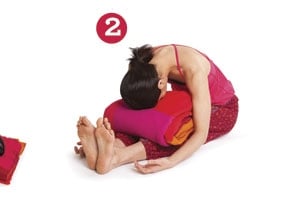
Having trouble sleeping? Before you spend another night tossing and turning, try doing these yoga poses and deep breathing exercises before going to bed.
Those who suffer from insomnia are familiar with sleepless nights and yawn-filled days. But before reaching into their medicine cabinets, sleep-deprived Australians might try tossing and turning onto a yoga mat to achieve a more peaceful slumber.
Why yoga?
Dr Sat Bir Singh Khalsa, assistant professor at Harvard Medical School, has researched yoga for more than a decade. In one of his studies, he found that eight weeks of practising yoga for 45 minutes before bedtime helped individuals suffering from insomnia fall asleep faster and improve their sleep time by about 12 per cent.
In Khalsa’s new e-book, Your Brain on Yoga (Rosetta Books, 2012), he explains how regular yoga practice changes the biochemistry of our body’s most important organ, influencing a myriad of physical and mental concerns—including sleep quality.
Speaking to alive by telephone, Khalsa explains that insomnia is a disorder of too much arousal, but “that’s exactly what yoga is very good at: reducing arousal”. He describes how the three components of yoga—meditation, breathing and physical postures—work together to affect deeper sleep.
Meditation regulates our attention, helping us to achieve more stable emotional reactivity and become more resilient to stress.
Deep breathing teaches us control and induces a relaxation-type response in the body.
Physical postures increase the mind-body connection, positively affecting the central nervous system and one’s state of well-being.
Choosing a yoga class
Selecting a yoga class can seem daunting. Chat with the yoga instructors from your local studio to learn which class is best for you and to see if they offer workshops specifically for yoga and sleep.
Khalsa says that a traditional style of yoga combining physical postures with meditation, mindfulness and breath work is most likely to beneficially affect one’s sleep. However, he notes that a mostly physical practice can also have sleep benefits.
Looking for a class closer to bedtime? Tianne Allen, a yoga therapist and instructor who specialises in restorative yoga, suggests a restorative style because it “triggers the relaxation response in the body, reducing stress levels, slowing the heart rate, reducing muscle tension, quieting the mind and ensuring a deep, restful sleep”.
Yoga at home
You don’t have to attend a class, or practise for hours a day, to reap the sleep benefits of yoga. “Relaxing for 10 to 15 minutes in a yoga pose before bed can make the difference between a restful sleep and lying awake all night”, says Allen.
Remove distractions
Before engaging in your home practice, make sure your space is free of distractions. Research shows that exposure to bright light before bedtime suppresses the onset and duration of melatonin, the body’s sleep-regulating hormone. So practise in a dimly lit space, or even try practising by candlelight.
Use props
A few props can make your practice more restorative. Cover up with a blanket to keep yourself warm and use pillows or blankets to support the body so that it is able to release, not actively stretch. You can also cover your eyes with an eye pillow to relax the optic nerve and relieve tension in the forehead muscles.
Release thoughts
Your mind may have difficulty settling into stillness, but be gentle on yourself: many people find the mental practice of yoga more challenging than the physical one. As thoughts come up for you, try not to judge or analyse them. Just notice them and let them pass by, bringing your attention continually back to your breathing.
Natural sleep remedies
- The extract of the root of valerian may improve sleep quality.
- Lavender, camomile and passion flower, inhaled as an aromatherapy treatment or drunk as tea, have potential sedative effects.
- Tart cherry juice has been shown to increase melatonin levels in the body, improving sleep quality.
Postures for cultivating sleep
Allen suggests the following series of three postures, held for five to 15 minutes each, to prep the body for slumber.

Legs up the Wall
- Lie in front of a wall or chair.
- Lift your legs up the wall or rest them on the chair.
- Place a blanket or pillow under your head for comfort.
- Allow your arms to open to the side.
Note: if you have lower back tension, place a blanket or pillow under your lower back.
Seated Forward Bend
- Sit with legs extended or crossed.
- Place pillows or folded blankets on legs.
- Allow your head to rest comfortably on the back of hands or on a pillow.
Note: if you have lower back tension, sit on a blanket or pillow.
Child’s Pose
- Sit on heels with knees hip-width apart.
- Place pillows or folded blankets in front of you.
- Rest head to one side, then turn to the other side for an equal amount of time.
Note: if hips do not reach heels, place a pillow or blanket between hips and heels.
Breathing exercises
Allen recommends incorporating one of the following two breathing exercises into the series of postures. She notes that the breathing exercises can also be utilised during the day to reduce stress or during the middle of the night if you wake up and cannot get back to sleep.
Deep Abdominal Breathing
- Inhale through your nose, letting the air move downwards into your lower belly.
- Let your abdomen expand fully.
- Exhale slowly through your nose.
Exhale Extension Breathing
Engage in deep abdominal breathing, but make your exhale longer than your inhale. For example, inhale for a count of 2 and exhale for a count of 4.





